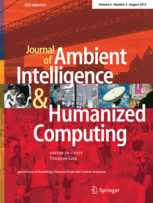S.I. on Real-time Risk and Behavioral Monitoring in IoT Applications using Soft Computing Techniques
Real-time multimedia level risk and behavioral monitoring is becoming harder, due to higher and rapidly increasing data induction. Data induction through electric smart devices is greater compared to information processing capacity. Nowadays, data becomes humongous even coming from the single source. Therefore, when data emanates from all heterogeneous sources distributed over the globe makes data magnitude harder to process up-to a needed scale. Big data and deep learning have become standard in providing well-known solutions built-up using algorithms and techniques in resolving data matching issues. Now, with the involvement of sensors and automation in generating data obscures everything. Predicting results to overcome a current era of ever enhancing demands and getting realtime visualisation brings the need of feature like human behavioral mode extraction to overcome any future threats. Soft computing techniques can bring the opportunity of predicting any misfortune even before they happen.
Recently, a meaningful development has been reported in the field of risk and behavioral monitoring. These achievements are mostly based on ICT techniques, such as body area networking, human assisted rehabilitation, and remote diagnosis. However, risk and behavioral monitoring (for example, integrating health services) with the existent communication method and providing remote medical treatments with accuracy and precision is still challenging task. To this end, the new soft computing based decisionmaking approaches that comprehend the research findings from the fuzzy and rough sets theory, neural networks, genetic algorithm, and artificial intelligence are actively developing. The scientific issue is how
to process these research findings in the field of risk and behavioral monitoring. Therefore, the research targets can be model construction using soft computing techniques and system approach how to building models and how to test and assess the performance.
The risk and behavioral monitoring is one of involute processes as the human generate the phenomena with substantial rate of chaotic actions. From our experience, it is known that to make a good decision it is suitable to utilize the soft computing methods which yield promising solutions. The soft computing methods, fuzzy and rough sets theory, neural networks, genetic algorithm, and artificial intelligence, can be utilized independently, or together. Therefore, soft computing methods can be used in wide range of applications. The promising decision making is a significant step for the success of risk and behavioral monitoring.
The topics of interest include, but are not limited to:
- Soft computing techniques for risk and behavioral management
- Signal processing and representing learning behavioral data
- Decision making under uncertainty with linguistic data
- Modeling risk in sequential decision making
- Fuzzy and rough sets theory for risk and behavioral monitoring
- Soft method in biomedical and medical application
- Neural network and genetic algorithms for risk management
- Real-time monitoring using soft computing based big data processing and analytics for IoT
- Real-time behavioral assessment in big data transmission with efficiency for IoT
- Soft computing based administration and interpretation of multimedia big data
- Behavioral feature based learning from big data to facilitate monitoring
- Soft computing based multimedia technology for monitoring system with IoT environment
- Image data collection, mining, and prediction methods based on soft computing
We also highly recommend the submission of multimedia with each article as it significantly increases the visibility, downloads, and citations of articles.
All the papers for this special issue will go through the online submission system and the standard peer review process of the Journal of Ambient Intelligence and Humanized Computing. Detailed guidelines for submission of the papers are kindly referred to “Instructions for Authors” of Journal of Ambient Intelligence and Humanized Computing. (http://www.springer.com/engineering/computational+intelligence+and+complexity/journal/12652)
Guest Editors
Marco Anisetti
Dipartimento di Informatica, Università degli Studi di Milano, Italy
marco.anisetti@unimi.it
Abdellah Chehri
Department of Applied Sciences, Université du Québec à Chicoutimi, Canada
Abdellah_Chehri@uqac.ca
Ernesto Damiani
Department of Electrical and Computer Engineering, Khalifa University, UAE
ernesto.damiani@ku.ac.ae
Gwanggil Jeon
Department of Embedded Systems Engineering, Incheon National University, Korea
gjeon@inu.ac.kr



